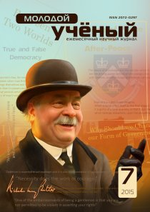The emergence of a new text language is due to the popularity of social networking services such as Facebook, Twitter, LinkedIn, various Internet forums, chat rooms, discussion boards and online gaming services. Internet communication is full of slang words, acronyms and abbreviations.
An abbreviation is a shortened form of a word or phrase. Until quite recently, abbreviation has been used only in political, juridical, military, scientific and economical spheres [2]. Nowadays it is used in everyday life, business communication, medicine, journalism, literature and art. Colloquial abbreviations, used in the Internet and mobile phones, contribute to the increase of communication services popularity [3, 4, 8].
There are three types of abbreviations in typology:
- author’s (occasional);
- textual;
- universally acknowledged [1, 5].
Researchers state that there are different reasons for the emergency of abbreviations and the ways of their formation. It is widely accepted that there are extralinguistic and intralingual factors for the origin of abbreviations.
Extralinguistic:
- scientific-and-technological advance, social and cultural development, international exchange, etc.
- widespread use of mechanical and technical communication.
Intralingual:
- commonness of language skills among speakers;
- influence of other languages;
- influence of everyday language and slang;
- tendency towards monosyllabism;
- specific features of the language [1, 6, 7].
However, in most cases abbreviations emerge due to the economy of speech means. Abbreviations are classified according to:
a) alphabetic acronyms (every letter is read as in the alphabet):
- BR — Best Regards;
- BFN — Bye For Now;
- BRH — Be Right Here;
- JK — Just Kidding;
- KBD — Keyboard;
- NP — No Problem;
- SH — Same Here.
b) initial acronyms (it includes a vowel):
- EM — e-mail;
- IB — I Am Back;
- IRL — In Real Life;
- ILY — I Love You;
- KIT — Keep In Touch;
- TIA — Thanks In Advance;
- TMI — Too Much Information.
c) portmanteau words (a word made from combining two words):
- blog — web and log;
- cyborg — cybernetic and organism;
- nanotech — nano and technology;
- sporgery — from spam and forgery;
- webinar — World Wide Web and seminar.
Figures and letters are also used in abbreviations:
- 10Q — Thank You;
- 121 — One To One;
- 143 — I Love You;
- 2U2 — To You Too;
- b4 — Before, etc.
Thus Internet abbreviations are making a significant impact on our use of daily language. They increase the effectiveness of communication, enrich the vocabulary of the language, attract readers’ attention and improve international communication in the era of globalization.
References:
1. Борисов В. В. Аббревиация и акронимия. Военные и научные технические сокращения в иностранных языках. М.: Военное изд-во МО СССР, 1972. 320 с.
2. Жаркова Т. И. Аббревиатура в межкультурной деловой коммуникации // Вестник Иркутского государственного лингвистического университета. 2012. Т. 2. № 19. С. 22–27.
3. Иванова Н. К. Английские аббревиатуры-неологизмы: особенности образования и написания // Вестник Пермского научного центра УрО РАН. 2013. № 4. С. 52–60.
4. Мартынова И. И. Аббревиатура как средство создания слов // Иностранные языки: лингвистические и методические аспекты. 2014. № 27. С. 88–95.
5. Мурычева A. C. Структурно-функциональные особенности конфронтируемых аббревиатур: (на материале англо-американской периодики): Дис.... к. филол. наук. М., 1991. 178 с.
6. Сергеева Т. С. Аббревиатура в системе лексических сокращений // Филологические науки. Вопросы теории и практики. 2013. № 6–2 (24). С. 174–179.
7. Шаповалова А. П. Опыт построения общей теории аббревиации: на материале французских сокращенных лексических единиц: Дис.... д-ра филол.наук. Ростов-на-Дону, 2004. 421 с.
8. Internet Abbreviation and Daily Communication. https://stephenleeatwork.wordpress.com/2013/09/04/internet-abbreviation-and-daily-communication (accessed March 30, 2015).







